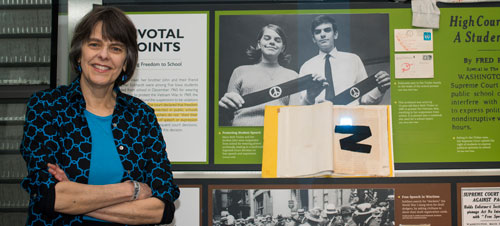February/March 2018 E-Newsletter
Check out our newsletter devoted entirely to resources and programs to help teachers and students discuss planned walkouts and increased student activism following the Parkland shooting.
Resources for making Parkland a First Amendment teachable moment
![]()
field trips | classes | tools | ideas | collections

A Day of Special Programming Built Around Student First Amendment Rights
In response to the Parkland tragedy and the groundswell of student activism across the nation, we have scheduled three special events on MARCH 13, the day before a planned nationwide student walkout. Q&A with Mary Beth Tinker (Live-streaming 11:30 a.m. to 12:30 p.m. ET) Youth rights advocate Mary Beth Tinker will join Newseum educators to discuss her landmark Supreme Court case on student speech and how it applies today. The hour-long presentation will be streamed live on Newseum.org and the Newseum's Facebook page, and will be made available shortly after as a recording on NewseumED.org. Students will be able to submit questions in advance or during the webcast via Twitter using the hashtag #my5freedoms. In 1965, Tinker, then a middle-school student, was punished for wearing a black armband to school to protest the Vietnam War. Watch Live > After-School Special: #my5freedoms (4:30-5:30 p.m. ET) We've created an opportunity for student journalists, student government members and other student leaders to have in-depth discussions about the issues and the upcoming walkouts and marches. RSVP to Webinar > #sschat: Today's Student Protests: A First Amendment Teachable Moment (7-8 p.m. ET) As school districts wrestle with whether to support student walkouts and political engagement, join us on Twitter to discuss how to make this time a teachable moment. Join the Conversation >
Resources for Constructive Conversations
We devote the rest of our monthly newsletter to resources to help with discussions in the classroom amid talks of student walkouts and political engagement. Our free, nonpartisan resources look at: media literacy skills to help sort through the information noise; First Amendment freedoms, their role in a democracy, and their limits; examples of when young people have stood up for causes in the past; and tips for teaching controversial topics. (To access some of these resources, you must be signed into NewseumED; registration is free.)
Media Literacy Connections
There's a flurry of stories and social media posts surrounding student demands for improved school safety and new gun laws. Some are intended to sow discord or spread false allegations and misinformation. In this climate, how do you know what's accurate or credible? Use our extensive media literacy tools to help students evaluate sources, determine motive, and verify the information. Among them:
- Lessons and videos: Sharpen your information evaluation skills to be a savvy media consumer.
- Infographics with supporting lessons: Stop the spread of propaganda by recognizing its signs in our Weed Out Propaganda lesson, and use the Is This Story Share-Worthy? flowchart before you retweet, like or share information.
First Amendment in Action
- Video: The Newseum Institute looks at the Founding Fathers' intentions with the First Amendment and provides guidance on using those rights.
- Lessons: What are the limits of free speech, in school and outside of it? Explore the extent of student rights with these activities: Allowed or Not Allowed? and Introduction to the First Amendment: What's a Violation?
- Free classes: The Tinker case is the foundation of our popular "You Can't Say That in School?!" and "First Amendment and Tinker" classes on First Amendment protections, and limits, in public school. In "You Can't Say That?!", students learn about restrictions to freedom of speech in public life. All classes are free and taught at the Newseum and virtually.
- Webinar for educators: Advocacy Amplified Through the First Amendment covers how activists in past social movements leveraged the power of First Amendment to bring about change, and applies their persuasive techniques to current issues.
Historical Connections
Today's Generation Z is not the first to raise their voices and demand change through protests. Examine how young people shaped history during the civil rights movement.
- Interactive timeline: Explore our "Making a Change: The First Amendment and the Civil Rights Movement" timeline to see how a new generation of student leaders fought segregation, including the lesser-known events of the 1951 Farmville Student Strike and the 1959 Youth March for Integration.
- Blog post: Collectively explore social movements and how groups, such as woman suffrage and civil rights activists, used the First Amendment to effect change. What strategies and goals did they share? Why did some tactics succeed while others failed?
Tackling Controversial Topics
- "From Provocative to Productive": This resource packet features techniques for leading conversations about "third-rail" subjects with students.
- Case studies: Use our cases on White House pickets and Confederate flag displays to debate forms of protest and challenges to the First Amendment.
- Quiz: Have students take our Buzzfeed-like quiz to discover their "freedom type" by answering timely questions on what liberties they'd sacrifice to keep our country safe. This is a good starting point for wider discussions on individual freedoms.
Follow NewseumED online! Twitter | Facebook | Pinterest
555 Pennsylvania Ave., N.W. | Washington, DC 20001 | © Newseum